Recent Fire Damage Posts
Handling Fire Damage In Your Home
2/20/2024 (Permalink)
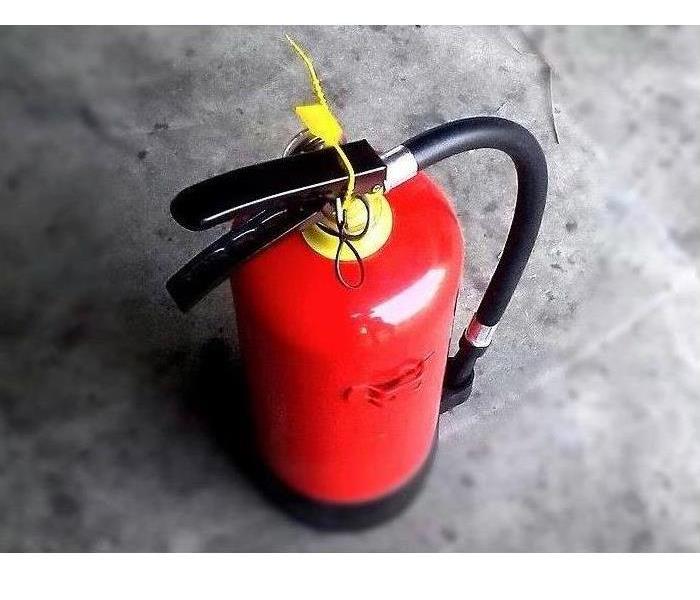 Call SERVPRO Team Lutz today to get help at 215.368.4110!
Call SERVPRO Team Lutz today to get help at 215.368.4110!
With any house fire, you could get hit with the loss of furnishings, electronics, sentimental items, and more. Not only will flames cause devastation, but there is also water from fire hoses and smoke and soot to address. SERVPRO knows how important it is for you to have a plan to get back on your feet. We’re Faster to Any Size Disaster, here for area residents 24/7 for emergency response.
Homeowners may not realize the possible impact on their health when subjected to fire damage. There will be dirty water left with contaminants from charred debris. Soot and smoke residue can have health effects for both humans and pets. You also have to worry about structural elements and instability until fire restoration gets completed.
Some steps to follow that will help you get ahead of the turmoil a fire leaves in its wake include:
- Seek temporary shelter, as entering fire damaged homes before they get deemed safe is dangerous.
- Contact your insurance provider, tell them about the blaze, and get your fire damage claim started.
- Get in touch with SERVPRO so we can mobilize a crew to your door within hours to begin the assessment and inspection.
Once we arrive, we will protect your property with the help of our board-up and tarping services. We cover windows and doors as well as holes in walls or your roof to protect it from the elements, vandals, and vermin.
Fire restoration commences, handling all residual moisture, charred debris removal, and addressing structural elements to return your home to pre-fire condition. Unsalvageable materials get replaced and finished to make it look “Like it never even happened.” Before wrapping up, our Odor Control Technicians (OCT) ensure no lingering odors get left behind to remind you of the fire.
Call us at SERVPRO Team Lutz when you need help with fire damage. Reach us 24/7 at 215.368.4110
What To Do After a Fire in Your Home
6/1/2023 (Permalink)
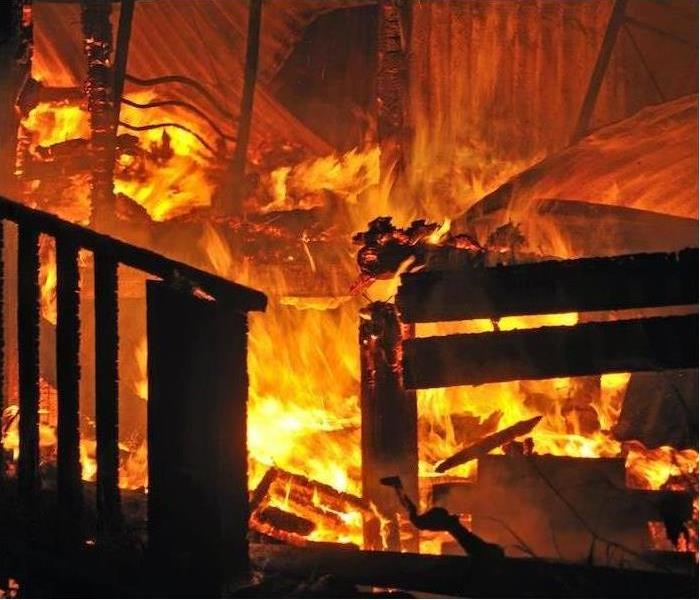 SERVPRO Team Lutz cares and wants to help. Call our office at 215-368-4110.
SERVPRO Team Lutz cares and wants to help. Call our office at 215-368-4110.
Experiencing a fire in your home can be a traumatic and overwhelming event. Once the fire is extinguished and everyone is safe, it's crucial to take immediate action to begin the process of recovery and restoration. Here are some important steps to take after a fire in your home:
Contact Your Insurance Company: Notify your insurance company as soon as possible to report the fire and initiate the claims process. Provide them with detailed information about the damage and follow their instructions regarding documentation and next steps.
Ensure Safety: Before re-entering your home, wait for clearance from the fire department or relevant authorities to ensure it is safe to do so. They will assess the structural integrity and utilities to ensure there are no immediate risks.
Document the Damage: Take photos or videos of the damage caused by the fire. This documentation will be helpful during the insurance claim process and when working with restoration professionals.
Secure Your Property: If necessary, secure your property by boarding up windows, doors, or other openings to protect it from further damage and unauthorized access.
Contact Restoration Professionals: Engage the services of a reputable fire restoration company. They will assess the damage, create a comprehensive restoration plan, and work to restore your home to its pre-fire condition. They will handle tasks such as debris removal, cleaning, smoke odor removal, and structural repairs.
Salvage Valuables: If it's safe to do so, retrieve any valuable items that were not significantly damaged by the fire or water used for firefighting. This may include important documents, jewelry, or sentimental items. However, avoid entering the property or handling items that may be hazardous due to smoke, soot, or water damage.
Address Immediate Needs: Make arrangements for temporary housing if your home is uninhabitable. Contact your utility providers to suspend services until the property is restored, and notify your postal service to forward your mail to a temporary address.
Communicate with Relevant Parties: Inform your family, friends, and employer about the situation and provide them with updated contact information. Inform your child's school about the situation as well.
Begin the Cleanup Process: Work with your restoration professionals to initiate the cleaning and restoration process. This may involve removing debris, drying out the property, cleaning soot and smoke residue, and addressing water damage.
Review and Update Safety Measures: Take this opportunity to review your home's fire safety measures. Install or replace smoke detectors, fire extinguishers, and carbon monoxide detectors as needed. Develop or update a fire escape plan and ensure everyone in the household is familiar with it.
Remember to take care of yourself and your family during this challenging time. Lean on your local SERVPRO Team Lutz to assist you through this process. With patience and the help of professionals like SERVPRO Team Lutz, you can gradually restore your home and move forward from the fire incident.
How Can I Avoid an Electrical Fire?
3/1/2023 (Permalink)
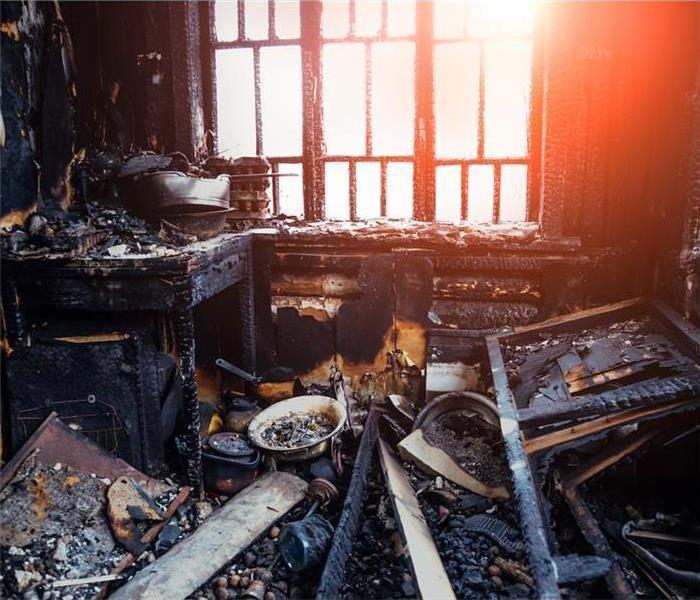 fire in living room area
fire in living room area
Electrical fires are one of the top causes of home fires in the United States. Our SERVPRO Team Lutz members are on standby 24-hours a day to respond to your call for help. We have been restoring fire damage for local residents for over thirty years! Here are some outdoor electrical safety tips from the National Fire Protection Association for outdoor electrical safety:
Outside Electrical Work
Have a qualified electrician do all electrical work
To prevent an electrical shock, make sure all your outside electrical receptacles are ground-fault circuit interrupter (GFCI) protected
Have a professional tree-cutting service trim any branches that might fall into electric wiring
Equipment Safety
Use lighting and power tools that a qualified test laboratory lists, and make sure they are made for outdoor use
Store your electrical tools indoors
Keep electric tools away from children
Keep the area around your electric meter and other electrical equipment clean
Check lighting and extension cords for damage before using. Replace any damaged cords right away
Use extension cords listed by a qualified test laboratory and marked for outdoor use.
Extension cords are not meant for long-term use
Call Us Today!
When you have a fire damage emergency in your home or commercial business, team is Here to Help. ® Call us today at 215-368-4110.
Franchises are independently owned and operated.
What To Do First When A Fire Occurs
10/4/2022 (Permalink)
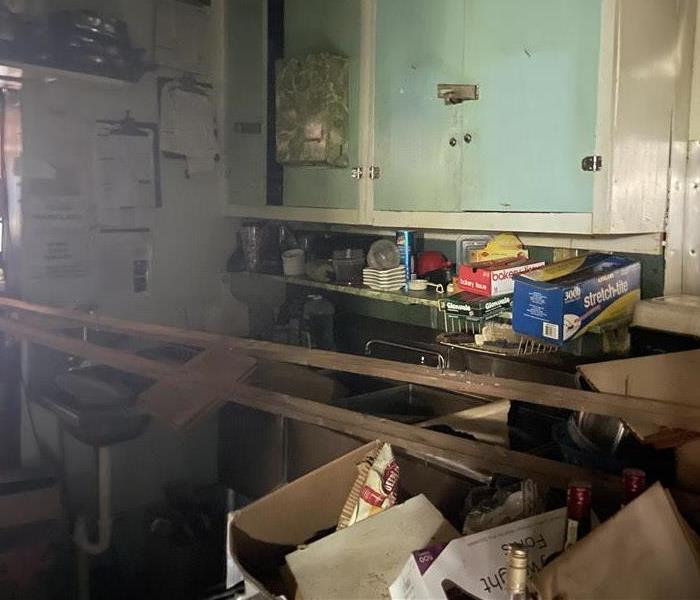 Call us at 215.368.4110!
Call us at 215.368.4110!
When a fire strikes your home it can be hard to know what to do first. Once the fire department allows you to get back into your home, what should you do? Damage can continue to happen to your home even after the fire is out so it is important to take steps. This means working with a professional repair and restoration team.
What Does Clean Up Look Like After A Fire?
Fires create many different types of damage. There is water damage that occurs when the fire is extinguished. If left untreated water damage can lead to rot and mold. There are also burned materials and smoke damage that needs to be handled carefully so that more damage does not occur. Anything that is damaged beyond repair needs to be safely removed. The team at SERVPRO of Lansdale, Warminster, Blue Bell, and Abington Jenkintown is ready to help you. They will assess the damage and create a plan for restoring your home.
Our Team Can Handle Many Types Of Damage
Often when a fire hits your home it will affect more than just the floors and drywall. You may also have plumbing or electrical repairs that need to be handled by a professional team. When looking for a repair and restoration team it's important to find one that can take care of all your restoration needs instead of having to hire out each part.
There is a lot of work to do after a fire. That's why our team at SERVPRO of Lansdale, Warminster, Blue Bell, and Abington Jenkintown Is ready to provide you with the guidance and support you need. Call our team after a fire to get the help you need.
Call us 24/7 at 215.368-4110.
24 Hour Service Even on Christmas!
10/3/2022 (Permalink)
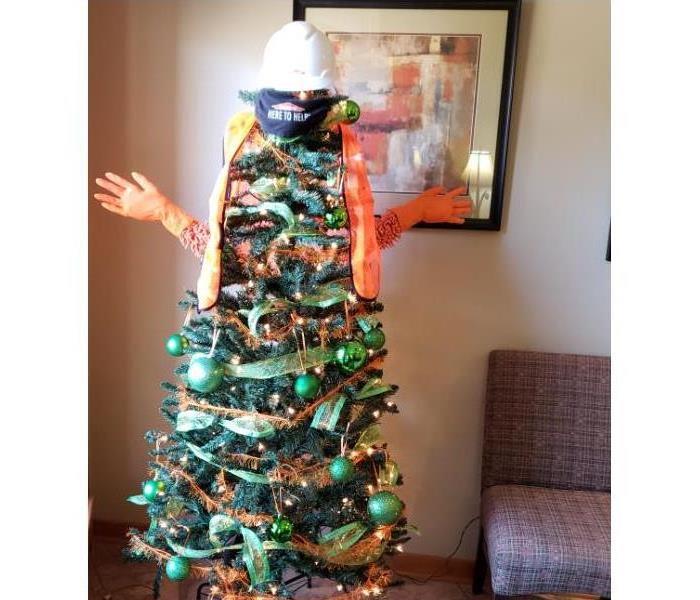 Happy Holidays!
Happy Holidays!
It's almost the best time of the year again, Christmas! We all love this time of the year whether you like putting up your Christmas tree, putting lights all around your home, or even baking cookies and having hot chocolate by the fireplace. Even with is being the jolliest holiday of the year accidents can still happen. It is important to keep safety at the top of your mind when getting your home ready for this holiday.
“According to the National Fire Protection Association, electrical distribution or lighting equipment was involved in 44% of home Christmas tree fires. Though Christmas tree fires may not be common, they can be devastating to more than the house itself. They can destroy irreplaceable photos, mementos, and family heirlooms and even cost lives,” says Isaacson. “To help keep your holidays bright and your home and family safe, use common sense with candles and tree placement, and follow these important home decorating guidelines.”
What are Puff Back Fires and How Can They Happen?
6/1/2022 (Permalink)
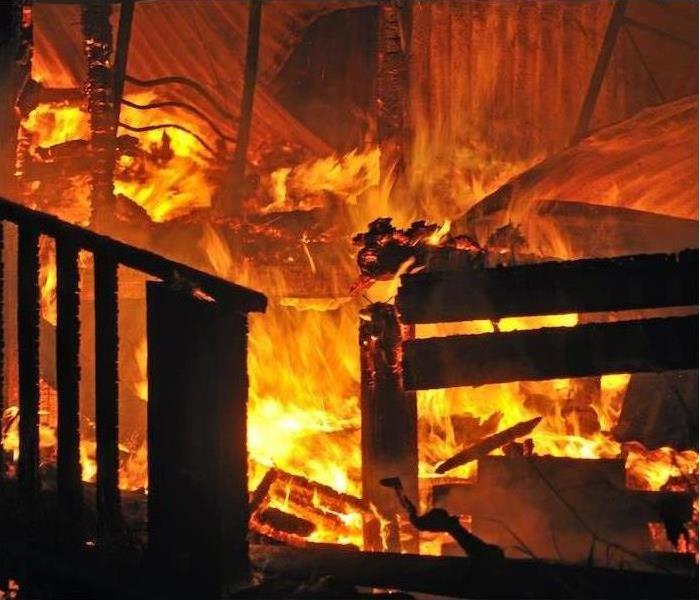 Call SERVPRO at 215.368.4110!
Call SERVPRO at 215.368.4110!
Puff back fires happen when your oil burner is running and the product of combustion, natural gas, is released into the air. It can occur when a burner's hot exhaust pipe comes into contact with combustible materials like dry leaves or even just water vapor that already exists in the air. The fire burns through these materials, releasing more heat and gases into the atmosphere and causing a massive explosion that disrupts your heating system.
Causes of a Puff Back Fires
There are several causes of puff backfires. The following are some of them:
Burner is clogged
The most common cause is a clogged burner. It's imperative to check your burners regularly, more than once a month, especially when it's cold outside. If your burner has formed a clog and you don't remove it, your system will not run as efficiently, and the chances of puff backfire increase.
Improper combustion
Another common cause of puff backfires is improper combustion. It occurs when there's not enough air or too much air is being fed into your burner. You must keep the burning process in a particular state to prevent the fire from overly combusting, which can cause a puff to backfire.
Chimney is clogged
There are many ways for a chimney to become clogged, but one of the most common is when too much ash builds up in the bottom. It is caused by an inefficient combustion process in your burner, which results in excessive ash being left over.
Low oxygen levels
Another cause of puff backfires is having too low oxygen levels in your air supply. When oxygen levels are too low, your combustion process cannot burn properly, and a puff will occur. Most boilers or furnaces have a mechanism that detects low oxygen levels and will shut off the device to prevent a fire, but you must check the levels yourself.
Gas leaks
Gas is not very compressible, and when it leaks into the air, it causes an increase in pressure which results in a puff backfire. It is most likely caused by the leak coming from your gas pipe. It could be the result of poor installation or poor maintenance.
Safety Measures
Proper installation and maintenance
You have to have a burner that is properly installed and maintained to avoid puff backfires. The best way to do this is to have a professional install your system because they are better trained. It will also reduce the chances that you have a gas leak or a clogged burner.
Reduce combustible materials
You should decrease the amount of combustible materials around your home. It would help keep your yard neat and tidy to avoid getting a puff to backfire from dry leaves and dead branches.
Proper ventilation
Another preventive measure is to have proper ventilation when using your fireplace or heating system. You should keep the windows open if you are in a room with an operating fireplace. It's also a good idea to keep an exhaust fan on while your system is running.
Use of safety shut-offs
You can also have a safety shut-off installed on your system. It will shut down the oil burner in case of low oxygen levels or a clogged chimney.
Puff back fires are very dangerous and can cause a lot of damage to your home. They are also preventable if you take the proper precautions. There are several reasonable safety measures that you can take, but it's best to have a professional come in and inspect your system if you have any doubts.
Accidents Happen - Fire Damage Repair and Restoration
4/4/2022 (Permalink)
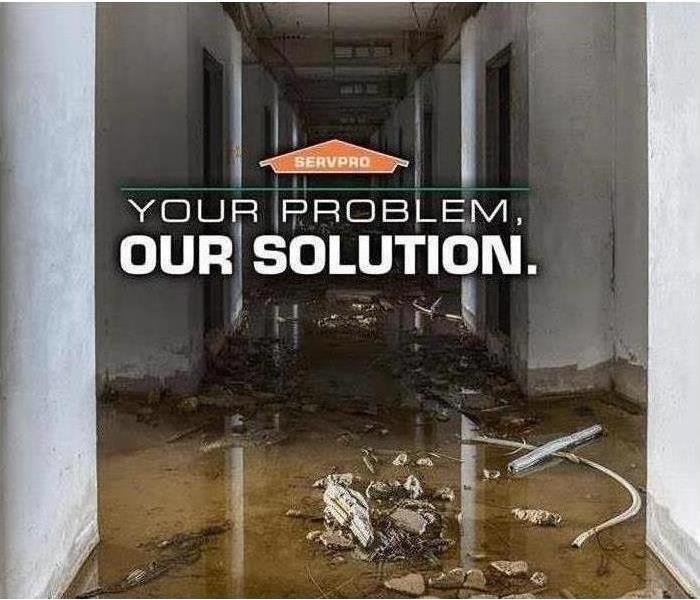 Call us at 215.368.4110, we would love to help!
Call us at 215.368.4110, we would love to help!
SERVPRO of Lansdale, Warminster, Blue Bell and Abington takes on the challenge of removing soot from all surfaces in a local home.
The homeowner was using a shop vacuum to clean up the soot in the fireplace not realizing that the filter for the shop vacuum was not attached. With the amount of soot spread throughout the home, she knew she would not be able to clean up the home on her own. She knew that hiring a professional soot damage restoration company that has experience is the best approach.
We use specialized equipment, chemicals, and techniques to remove soot from ceilings, walls, and other surfaces. In areas of the home with severe damage, we use multiple techniques to restore the home. Crews hepa vacuum all surfaces to remove soot, dry sponges to wipe surfaces that could not be wet washed, and the carpeting was steam cleaned.
Our Restore vs. Replace Mentality
We clean and restore your property using specialized equipment and cleaning techniques. Our “restore first” mentality reduces interruption and gets you back to your life.
If you need Fire Damage Repair and Restoration your call is at 215-368-4110.
3 Tips for Reducing the Risk of Space Heater Fires
4/1/2022 (Permalink)
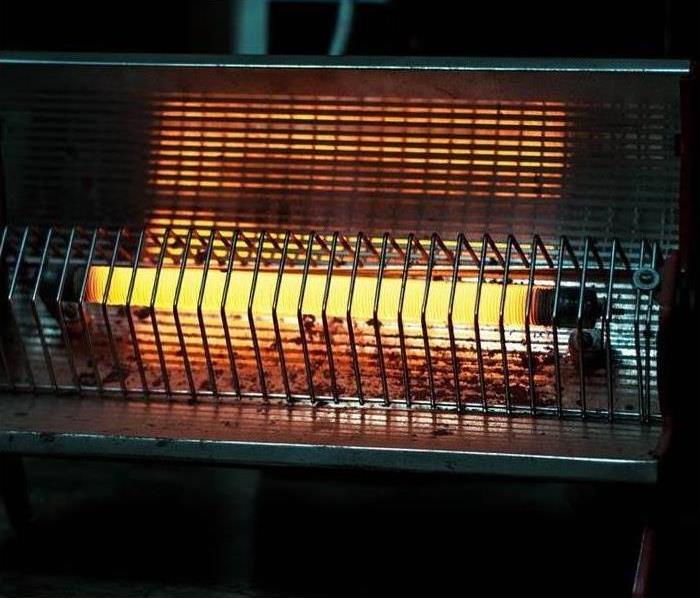 Space heaters are portable devices designed to heat single rooms rather than entire houses.
Space heaters are portable devices designed to heat single rooms rather than entire houses.
Using space heaters can be a convenient way to keep certain areas of your home cozy, especially those that do not receive enough heat from the furnace or are located on an outer ground floor. While these units can be handy, they might also increase the risk of a fire and a burned space heater. Keeping a few safety tips in mind can help you reduce the possibility of space heater fires and ensure your family’s well-being.
1. Give the Unit Space
One of the most common causes of space heater fires is putting heaters in an area where they do not have enough room for proper heat flow. This can cause the unit to overheat and start a fire. Putting a heater in an enclosed space can also cause objects around it to catch fire, such as bedding, clothing and other fabrics. The risk is usually highest in the bedroom, where blankets and stuffed toys can fall off the bed and onto the heater and spark a blaze. A fire and smoke cleanup service can advise you about the best placement for your space heater.
2. Ground the Plug at a Wall Outlet
Most space heaters are designed to operate from one electrical socket. As such, plugging them into an extension cord or a multi-socket power strip may cause them to overheat. This may start at the plug itself, which can melt it or the cord. Overheating at the power source may also cause a power surge, which can result in a burned space heater or a fire.
3. Set Your Heater on a Stable Surface
When you first buy a space heater, it is important that you read all instructions and set your unit on a stable surface instead of a table or other object. If the surface is unstable, the unit can be knocked over and come into contact with flammable objects.
Space heaters can make your home comfortable. However, knowing how to use them safely is important to protect your family from the threat of a burned space heater or a devastating fire.
Kitchen Cooking Safety: 3 Tips
3/9/2022 (Permalink)
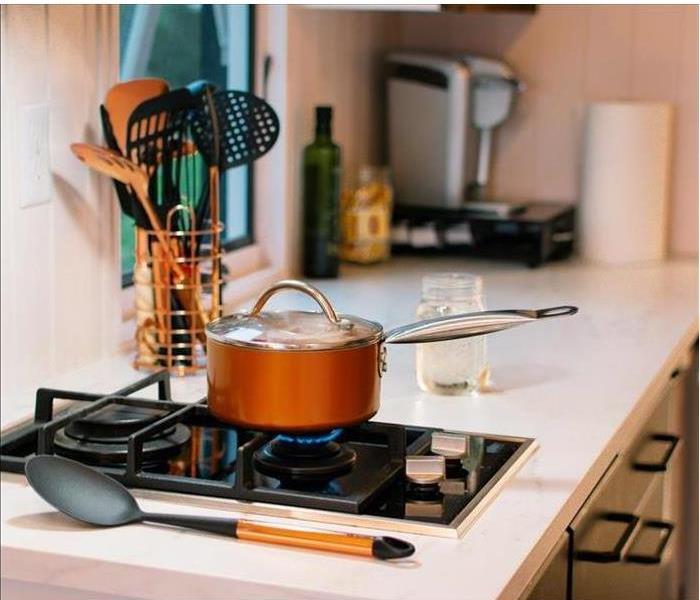 Protect your kitchen and the rest of your home from the destructive nature of fire damage by educating yourself on kitchen fire safety best practices.
Protect your kitchen and the rest of your home from the destructive nature of fire damage by educating yourself on kitchen fire safety best practices.
“The leading cause of fires in the kitchen is unattended cooking,” according to the National Fire Protection Agency. They also report that the appliance most commonly involved in kitchen fires is your stovetop, but kitchen fires can stem from a variety of sources if improperly monitored. Altogether eliminating the possibility of an unwanted fire igniting is virtually impossible, but you can best protect your kitchen and the rest of your home from the destructive nature of fire damage by educating yourself on kitchen fire safety best practices. Continue reading to learn more about 3 of the NFPA’s cooking fire safety tips.
- Don’t Stray Too Far from the Kitchen
There are different recommendations based on what kind of cooking activity you are conducting in the kitchen. Stovetop activities, such as frying, boiling, broiling, and grilling, require you to stay in the kitchen for the entire process so that you can monitor the area and take action immediately if a fire ignites. If a situation arises that requires you to leave the kitchen for any amount of time, it is strongly advised that you turn the stove off completely. Contrastingly, cooking activities that require more cooking time, including roasting, baking, and simmering, may be safe to leave the kitchen, but only for short periods of time. If you must leave the kitchen, it is a good idea to regularly check in and set a timer in order to decrease the risk of fire.
- Know What to Do When an Oven Fire Occurs
We’ve discussed what to do in the event of a stovetop fire, but what is the best course of action for dealing with an oven fire? Suppose something that you’re baking catches fire in your oven. The NFPA suggests that you turn the heat off as soon as possible and do not open the oven door until the fire is extinguished. Opening the door may facilitate the spread of the fire. If the fire does not go out on its own, call 911 immediately.
- Keep Your Cooking Area Clear of Flammable Objects
All around your cooking area, you may possibly find a wide variety of flammable objects that are not necessarily out of place. By an oven, there are usually oven mitts, which are flammable, as well as towels and wooden utensils. These are all helpful tools when cooking, but they can also facilitate the quick spread of an unwanted fire in the event that one ignites. In order to prevent any unwanted fires from spreading, it is beneficial to keep flammable kitchen objects and tools tucked away, stored in cabinets or drawers when not in use.
Experienced a Fire? Call SERVPRO
No matter what kind of fire your home or business may experience, know that SERVPRO of Warminster, Lansdale, Blue Bell and Abington Jenkintown is just a call away. If your property sustains fire damage to any degree, call us at 215.368.4110 for immediate assistance. Here at SERVPRO, we are committed to making your property damage “Like it never even happened.” By visiting our website, you can also learn more about our Fire Damage Restoration services, tailored to both residential and commercial properties in order to best meet your needs. Additionally, you can find more information about our other fire-related cleaning services, including Odor Removal and Deodorization. Be sure to also check out our best Fire Damage Tips.
Fire Safety Equipment: Five Pieces You Need for Your Home
10/5/2021 (Permalink)
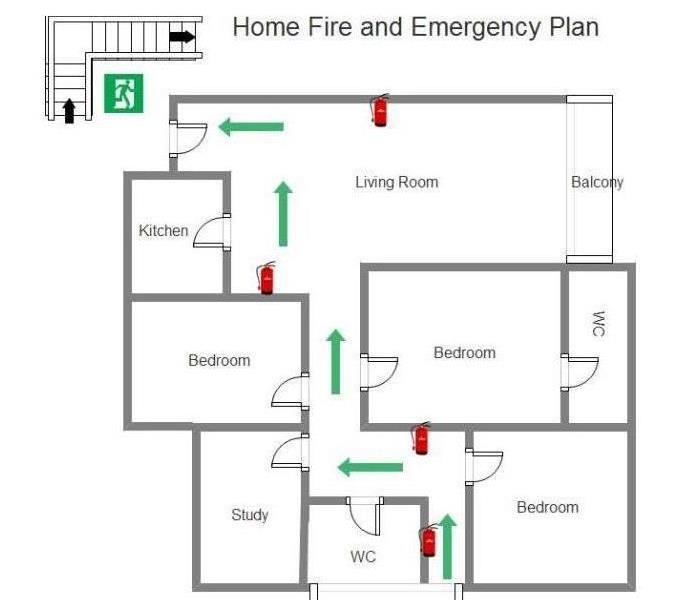 A fire safety plan can also be helpful in the even of a fire.
A fire safety plan can also be helpful in the even of a fire.
Our homes may be our sanctuaries, but they also present multiple opportunities for fire danger. An unattended stovetop can result in a kitchen fire, while electrical systems and appliances can overheat. Fireplaces, candles, flammable liquids, and outdoor grills — to name just a few — all add to the risk.
Having the correct fire safety equipment in your house is essential to keep your family safe and your home protected. This article highlights the five most important pieces of equipment needed to safeguard your home and loved ones. The peace of mind that comes from knowing you’re prepared is worth the time, effort, and expense involved.
Smoke Alarms
This is your first line of defense. According to the Red Cross, the National Fire Alarm Code (NFPA 72) requires all new homes to have inter-connected hard-wired smoke alarms with battery backup. If you don’t have an interconnected system, battery-powered alarms are easily installed. Both types of alarms need to be located on every level of the home with one inside each bedroom.
Fire Extinguishers
Since most home fires start in the kitchen, you’ll want to put a fire extinguisher in there, at a minimum. But it’s recommended to place them in multiple locations around the house. Since extinguishers from various makers all work differently, it’s a good idea for the adults in the household to get training from the local fire department. Extinguishers should be installed near exits, away from heat sources, and up high enough that kids can’t reach them.
Sprinkler Systems
While a smoke alarm will detect smoke, an automatic sprinkler system gives you a way of dealing with flames immediately. While you’re waiting on the fire department to arrive, sprinklers can help slow a fire’s progress or can even douse it completely. Moreover, a sprinkler system can prevent deadly gases and smoke from affecting your family and could also extinguish a fire that breaks out while you’re away from home.
Carbon Monoxide Alarms
There’s a good reason carbon monoxide (CO) is called the “silent killer.” This deadly gas is invisible, odorless, and colorless and even a small amount can be fatal if inhaled for long enough. Install carbon monoxide alarms on each level of your home and outside bedrooms. If the alarm emits its high-pitched warning, get outside as quickly as possible or open windows and doors and take deep breaths of fresh air. CO poisoning can cause headaches, nausea, and tiredness and can be mistaken for flu.
Fire Escape Ladders
If your home has more than one floor, collapsible fire ladders should be a part of your fire-safety arsenal. Place a ladder where it’s easy to access in every upper-level room in case your evacuation route gets cut off by smoke or fire. Then, have the entire family rehearse the steps they would take to get the ladders out and attached to open windows.
No one wants to dwell on the possibility of their family being in danger or their home being consumed by flames, but this is one situation where being properly prepared could save lives and property. If you haven’t already done so, make an escape plan and go over it with your family. And check your homeowner’s insurance to make sure your policy is up to date with adequate coverage.
What to Do After a Fire
10/4/2021 (Permalink)
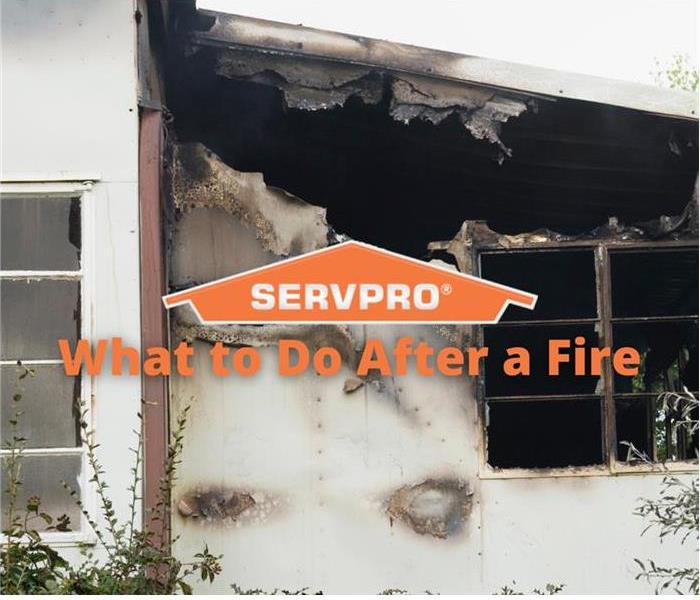 Call us at 215.368.4110!
Call us at 215.368.4110!
After the fire trucks leave, your home likely suffers from fire and smoke damage and extensive water damage from firefighting efforts. SERVPRO Franchise Professionals have the specialized fire restoration training needed to restore your home to pre-fire condition.
Have Questions About Fire, Smoke, or Soot Damage?
Call Today 1-800-SERVPRO
Every fire damage event is a little different, and requires a unique solution, but the general process stays the same. The steps listed below illustrate our process for the “typical” fire damage emergency.
Step 1: Emergency Contact
The restoration process begins when you call the SERVPRO Customer Care Center, which is staffed 24 hours a day. Our specialist will ask a series of questions regarding the fire damage event that will help us dispatch the nearest SERVPRO Franchise Professional with the appropriate equipment and resources.
Step 2: Inspection and Fire Damage Assessment
Our Professionals will carefully inspect and test adjoining rooms of your property to determine the extent of the fire, smoke, and soot damage. This step is crucial to developing a plan of action.
Step 3: Immediate Board-Up and Roof-Tarp Service
Fire damage can often compromise windows, walls, and roofs. To maintain security and to protect against further damage, the SERVPRO Franchise Professional can board up missing windows and walls and place tarps on damaged roofs.
Step 4: Water Removal and Drying (if water damage is present)
The water removal process begins almost immediately and removes the majority of the water. They will then use dehumidifiers and air movers to remove the remaining water and complete the drying process.
Step 5: Removal of Smoke and Soot from All Surfaces
The SERVPRO Franchise Professionals use specialized equipment and techniques to remove smoke and soot from ceilings, walls, and other surfaces.
Step 6: Cleaning and Sanitizing
They will clean all of the restorable items and structures that were damaged by the fire. They use a variety of cleaning techniques to restore your belongings to pre-fire condition. They’re also trained to remove odors using industrial air scrubbers and fogging equipment.
Step 7: Restoration
Restoration is the final step—getting your home or business to its pre-fire condition. Restoration may involve minor repairs, such as replacing drywall, painting, and installing new carpet; or it may entail major repairs such as the reconstruction of various areas or rooms in a home or business.
Top 3 Gas Range Cleaners
6/3/2021 (Permalink)
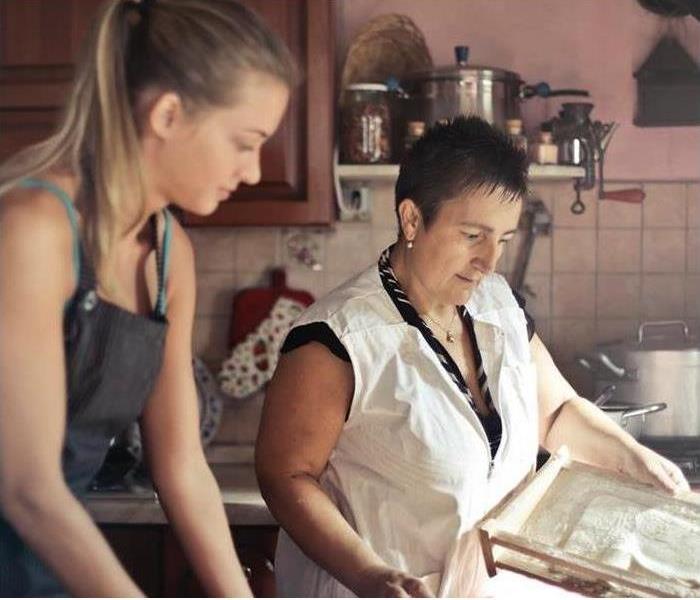 Good fire safety practices are important to keep your family safe!
Good fire safety practices are important to keep your family safe!
When you cook at home, food debris and grease accumulate on a stovetop. Glass-top electric ranges call for specialized cleaning solutions, but several standard household cleaners can be effective for a gas range.
1. Vinegar
Distilled white vinegar is a common household cleaner. Diluted acetic acid can loosen food stuck onto the surface of a gas range, dissolve cooking grease and banish the smoke smell. For more scrubbing power, sprinkle the stove surface with baking soda.
Most cleaning experts recommend making a one-to-one mixture of 5% distilled vinegar or 6% cleaning vinegar and water to clean a stovetop. Remove the grates before spraying the surface and allow the vinegar to sit for a minute before wiping.
2. Dish Soap
Dish soap contains degreasing agents. If you do not have vinegar on hand or prefer to use soap, you can use this mixture to clean the entire stove or focus on areas with built-up grease.
If you plan to clean the entire range with dish soap, you may want to spray on a diluted mixture. You can also use full-strength soap on grease buildup by applying this cleaner directly to a scrub brush.
3. Degreaser
If it has been a while since your last range cleaning, you may get the best results from the degreaser. These powerful cleaning formulas are formulated to dissolve heavy buildup.
Follow the instructions for any brand of degreaser you buy. These treatments should generally be sprayed on and given several minutes to penetrate before being wiped off.
It is important to regularly wipe down the gas range at your residence. A dirty stove and combustibles that are kept too close to cooking areas can cause or intensify a kitchen fire. Regular cleaning and good fire safety practices can greatly reduce the risk of a house fire.
As a Renter, Does My Insurance Cover Fire Loss?
4/5/2021 (Permalink)
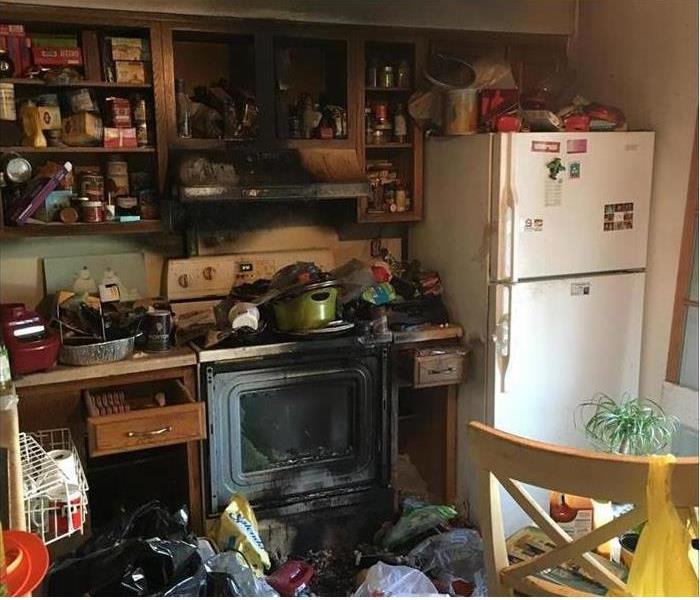 Fire Damage in a local Lansdale Home
Fire Damage in a local Lansdale Home
Insurance can be confusing. As a renter of your residence, it can be even more complicated to understand exactly what renters insurance does or doesn’t cover. After all, you don’t own the building, but you certainly have an investment in your own belongings. If your home sustains a fire disaster what does this insurance coverage typically include?
1. Personal Property
This coverage includes fire damage caused by the negligence of you or someone else (criminal acts are excluded). While your policy doesn’t cover the structure in which you live or any property owned by your landlord (walls, light fixtures, flooring, appliances — your landlord’s policy covers these), it does include the loss of your personal property (except for your vehicle). Fortunately, it usually covers the replacement cost instead of the actual cash value. So, you’ll receive payment on what it costs to replace the item versus the depreciated value. Subsequent damage such as smoke and/or soot is also covered.
2. Loss of Use
Oftentimes a fire causes such extensive loss that the home is unlivable. Your insurance will reimburse you for living expenses (e.g., hotel stays) during the fire restoration process.
3. Liability
A fire caused by your negligence could cause injury to someone else (i. e., a neighbor or visitor) or cause their property to sustain damage. Your renters insurance will step in to cover these losses.
4. Medical Expenses
If someone sustains a small bodily injury as a result of your fire, “medical payments to others” will pay for their medical bills. This is no-fault coverage, which means that it doesn't require determination of fault, unlike liability coverage, allowing for faster reimbursement.
If you're renting your residence in the Philadelphia area, renters insurance isn't required but could be worth the extra expense for the added assurance. Fire damage cleanup experts will return your home to its preloss condition in the event of a fire.
Your dryer can cause a home fire.
4/1/2021 (Permalink)
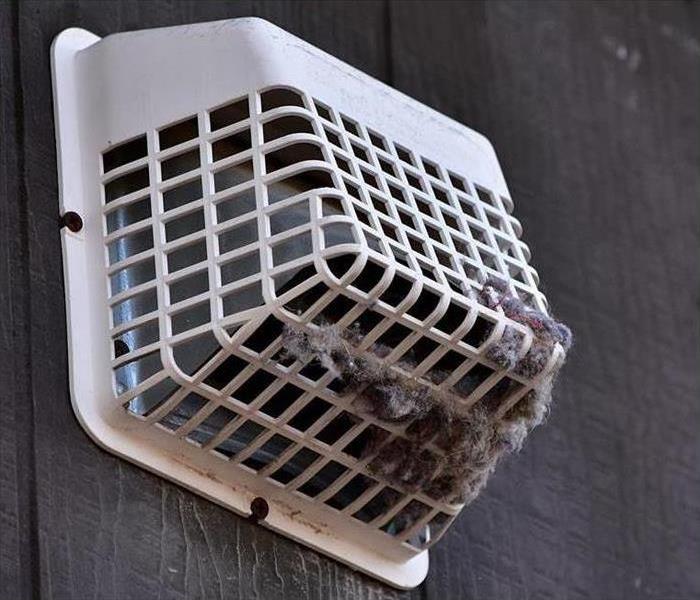 We can handle a small or large fire! Call us at 215.368.4110! We'd love to help!
We can handle a small or large fire! Call us at 215.368.4110! We'd love to help!
As a homeowner in the Philadelphia/Bucks County Area, you're probably very diligent about fire safety. You may have a fire extinguisher and smoke detectors on every floor, but have you checked your dryer vent lately? Many homes are damaged each year as the result of a lint fire. If the vent isn't cleaned out regularly, a dryer fire can result.
- Clothes Are Taking Too Long To Dry
If your vent is blocked, your clothes can take up to two or three times as long to dry. You may find that the clothes you put in for a regular drying time are still a little damp when the cycle is over. This is happening because the blocked vent isn't allowing the moisture to be released to the outside.
- Hot Dryer and Clothes
A blocked vent can also cause excess heat. If your laundry feels unusually hot when you take it out, and the outside of the dryer feels very hot when you touch it, this could be the problem.
- Burning Smell
If you smell something burning inside the dryer, that's a sure sign of trouble. The drum casing, exhaust tube, and trap can get clogged, which makes it easy for a lint fire to start. If you're smelling smoke, turn off the dryer immediately and call a professional right away to inspect it.
- No Regular Inspections
Your dryer vent should be inspected at least once a year by a vent cleaning specialist. A do-it-yourself job is certainly an option, but hiring a professional can ensure that the job is done thoroughly. These technicians are well acquainted with all the various brands of dryers and have the proper equipment to efficiently clean out the vent.
A lint fire can be a dangerous situation and cause a great deal of damage. But you can easily prevent a fire from happening by looking out for the signs outlined above.
Common Causes of House Fires
3/3/2021 (Permalink)
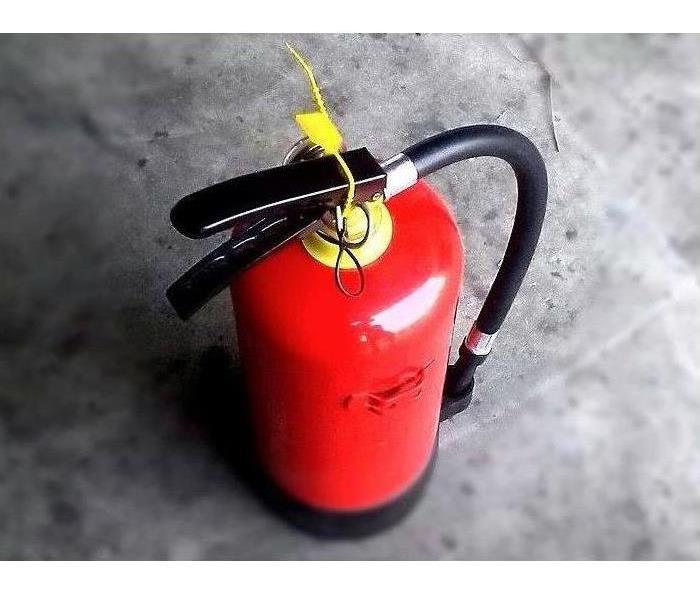 Call us at 215.368.4110. We are happy help!
Call us at 215.368.4110. We are happy help!
Fire damage may result in ways you least expect. Take precautionary measures now to protect your home from the following fire instigators.
- Cooking equipment: Cooking equipment is the number one cause of house fires. Pots and pans can quickly overheat when left unattended or mishandled. Be sure to always turn your handles towards the middle of the stove to avoid children from accidentally grabbing it. When leaving the house, always remember to turn off stove and oven.
- Smoking in Bedrooms: Avoid smoking in bedrooms. A cigarette butt can stay lit for hours and cause a flame after coming into contact with clothes or furniture. Open flames such as candles can also pose a danger for many residents.
- Old electrical equipment: Older lampshades and light fittings may build up heat, and weak bases could pose a tipping hazard. Electrical equipment such as these should be checked for faulty cords, and the power point must not be overloaded with double adapter plugs.
- Flammable liquids: Liquids such as petrol, kerosene, or methylated spirits should be kept away from heat sources and stored properly according to their label.
When accidents happen, SERVPRO of Lansdale, Warminster, Blue Bell and Abington Jenkintown is here to help and restore your home quickly and professionally. Give us a call at 215.368.4110.
Fire Pit Tips
10/1/2020 (Permalink)
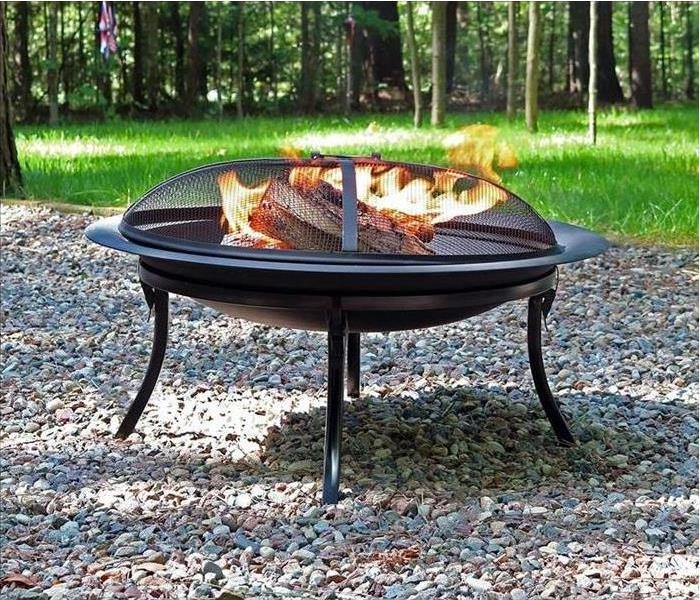 If you have a fire issue, commercial or residential call us at 215.368.4110. Faster to any size disaster.
If you have a fire issue, commercial or residential call us at 215.368.4110. Faster to any size disaster.
Home Fire Pit Tips
Fall is coming and for many families its a tradition to enjoy the nights outside around a homemade fire pit! Many of us are looking forward to spending time gathering around them to enjoy time with family and friends. Before you start dreaming of moonlit nights and toasted marshmallows, take a moment to check out some of these tips from Allstate to remember.
Backyard Fire Pit Safety Tips:
- Whether you prefer a built-in or portable fire pit, choose one that is not too large for the area. The pit should be a minimum of 10 feet away from any structures or combustible materials as well as away from trees, fences, sheds, power lines, and telephone wires, 25 feet away from apartment or multi residence buildings.
- Make sure that the seating area is large enough and properly placed for comfort and ventilation.
- Check wind direction before lighting a fire.
- Don’t use flammable fluids (gasoline, lighter fluid, etc.) to light or relight fires.
- To start the fire, use a lighter to ignite crumpled pieces of paper covered with small sticks. Then, add larger sticks and a log or two to keep it burning.
- Burn only dry material. Damp material will create excess smoke.
- Use a commercial fire pit screen on top to help prevent large amber from leaving the controlled area.
- Don’t wear flammable clothing (like nylon) or any loose-fitting clothing.
- Never leave the fire unattended, and keep pets and children far away from the fire as they will be attracted to it.
- Keep a fire extinguisher, garden hose, or bucket of water nearby.
- As the fire dies down, use a shovel and spread out the ashes to allow them to cool down. Then slowly pour water over those ashes and watch them closely to be sure that no burning embers remain or reignite. Put the cooled ashes in a specially designated ash storage metal can.
Fire Emergency Plans and Why We Need One
10/1/2020 (Permalink)
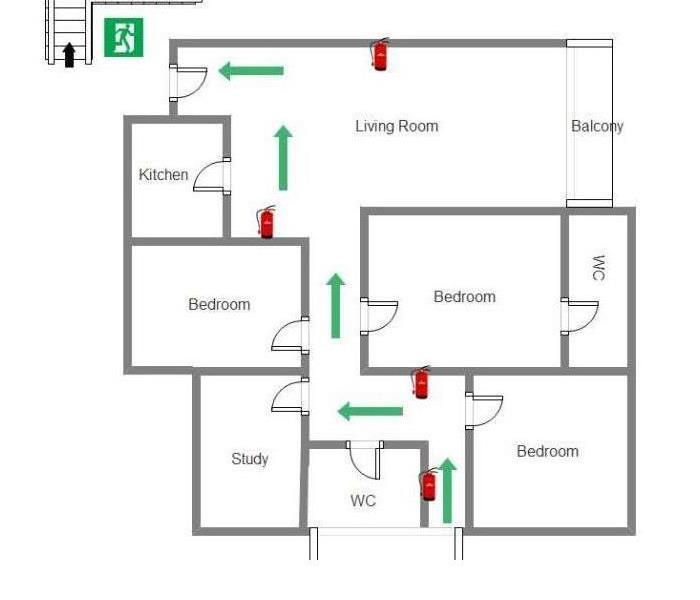 Home Fire and Safety Plan
Home Fire and Safety Plan
We are all busy with kids, school, work, after school activities, but we all need to take some time out of our busy schedule, and make a family fire plan. I know as a parent it's hard to juggle family life, but safety for my family is always on my mind. Here is what you can do.
- Make a map of your home, and make a fire exit plan. Post you fire plan in the kitchen area a daily reminder.
- Teach safety techniques like step by step how to instructions to stay low to the ground, and cover your face with your shirt or a pillow case to protect from the smoke
- Conduct drills like listening for the smoke detector, and practicing the fire exit plan for evacuation.
- Talk about fire safety with your children. Play games to teach them stop drop and roll, and to be ready for if a fire if it happened in your home.
If a fire happens in your home, SERVPRO of Lansdale, Warminster, Blue Bell and Abington Jenkintown can help you fix your home. We are here for you and your home 24/7.
How To Clean Up After Smoke Damage
6/3/2020 (Permalink)
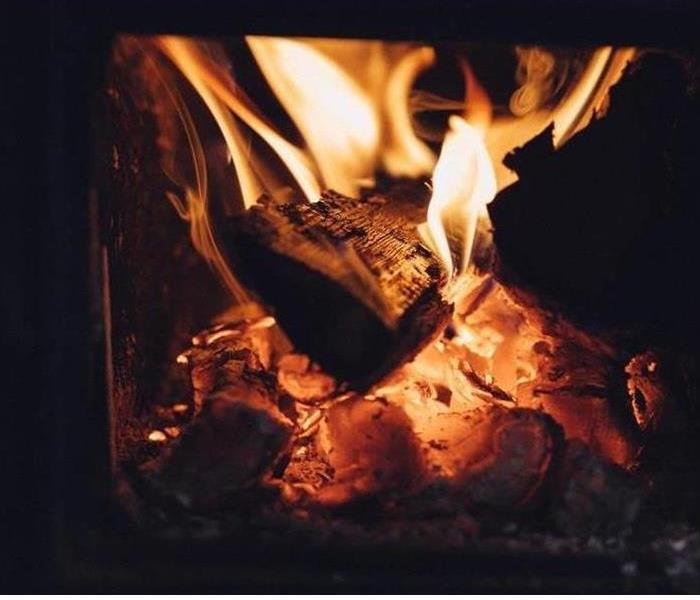 We would love to be the ones your trust after a fire in your home or business! Call us at 215.368.4110!
We would love to be the ones your trust after a fire in your home or business! Call us at 215.368.4110!
After a fire, contacting a cleaning professional may be the best decision you can make, since fire will affect everything in your home or business, through the flames, heat, soot, and smoke. Your structure can even be adversely affected. You’ll need the assistance of professionals who have the expertise and equipment that is needed to get your work or personal space back to normal as soon as possible.
Unsafe Conditions. Inhaling smoke can have an immediate negative effect on you, even if it’s only for a short time, so avoiding a smoky situation is really important. With that in mind, you won’t want to enter your home or business until all the smoke is cleared from your premises. Hiring a professional fire and smoke damage restoration contractor will ensure that your property is free from the after-effects of a fire quickly and thoroughly.
Cleaning Methods. SERVPRO specializes in restoring the contents of a home or business that has suffered from fire damage or water damage. The team will assess all your belongings carefully to determine which items can be restored to their “pre-fire” condition and will use several cleaning methods to restore your property to its original condition. These can include:
- Foam. This is used for upholstery since upholstery can shrink or the colors may bleed if water is used.
- Dry. This method is used to get rid of light residue.
- Wet. This is a very effective cleaning method, used to remove moderate to heavy residues.
- Immersion. In this method, items are dipped into a bath of cleaning products for a thorough cleaning that removes heavy residues and overwhelming odors.
Electronics. Electronics that have been damaged by fire and the accompanying smoke often present a serious hazard, so never turn your electronics on after they have been damaged by fire, just to be safe. Smoke residue contains acids that corrode metal and that can cause electronic failure in a device. Computers, televisions, and CD/DVD players should be assessed and cleaned by a professional before they are used again.
If the smoke and fire damage to your home or business is such that it will need extensive restoration or cleaning, SERVPRO can organize your move-out process if that is necessary. Removing your items from the area will help any remodeling process go a lot faster, as well as l protect your items from any further potential damage. Once that is complete we can then coordinate and organize your move back into your premises so you can get back to normal.
If your home or business has suffered damage from fire, water, or mold, here at
After a fire, contacting a cleaning professional may be the best decision you can make, since fire will affect everything in your home or business, through the flames, heat, soot, and smoke. Your structure can even be adversely affected. You’ll need the assistance of professionals who have the expertise and equipment that is needed to get your work or personal space back to normal as soon as possible.
Unsafe Conditions. Inhaling smoke can have an immediate negative effect on you, even if it’s only for a short time, so avoiding a smoky situation is really important. With that in mind, you won’t want to enter your home or business until all the smoke is cleared from your premises. Hiring a professional fire and smoke damage restoration contractor will ensure that your property is free from the after-effects of a fire quickly and thoroughly.
Cleaning Methods. SERVPRO specializes in restoring the contents of a home or business that has suffered from fire damage or water damage. The team will assess all your belongings carefully to determine which items can be restored to their “pre-fire” condition and will use several cleaning methods to restore your property to its original condition. These can include:
- Foam. This is used for upholstery since upholstery can shrink or the colors may bleed if water is used.
- Dry. This method is used to get rid of light residue.
- Wet. This is a very effective cleaning method, used to remove moderate to heavy residues.
- Immersion. In this method, items are dipped into a bath of cleaning products for a thorough cleaning that removes heavy residues and overwhelming odors.
Electronics. Electronics that have been damaged by fire and the accompanying smoke often present a serious hazard, so never turn your electronics on after they have been damaged by fire, just to be safe. Smoke residue contains acids that corrode metal and that can cause electronic failure in a device. Computers, televisions, and CD/DVD players should be assessed and cleaned by a professional before they are used again.
If the smoke and fire damage to your home or business is such that it will need extensive restoration or cleaning, SERVPRO can organize your move-out process if that is necessary. Removing your items from the area will help any remodeling process go a lot faster, as well as l protect your items from any further potential damage. Once that is complete we can then coordinate and organize your move back into your premises so you can get back to normal.
If your home or business has suffered damage from fire, water, or mold, here at SERVPRO of Lansdale, Warminster, Blue Bell, and Abington Jenkintown we handle fire and water damage projects of all sizes, and we are mold prevention and remediation experts too.
How to Safely Use Your Fire Pit
4/8/2020 (Permalink)
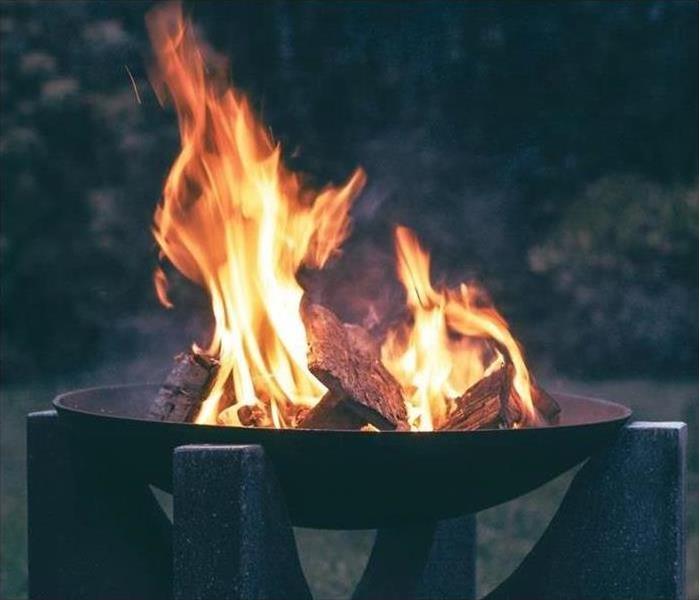 Have fun and be safe!
Have fun and be safe!
Now that it’s becoming more pleasant outside, many of us are uncovering our firepits and looking forward to spending time gathering around them to enjoy time with family and friends. Practicing fire safety is going to be an important thing to remember.
Let’s have a quick refresher on how to safely use your firepit:
Whether you prefer a built-in or portable fire pit, choose one that is not too large for the area. The pit should be a minimum of 10 feet away from any structures or combustible materials as well as away from trees, fences, sheds, power lines, and telephone wires.
Make sure that the seating area is large enough and properly placed for comfort and ventilation.
Don’t start your fire if it’s really windy; a strong breeze can easily blow sparks onto nearby flammable materials, such as firewood piles or roofs, and can hurt people, too.
Burn only dry material. Damp material will create excess smoke.
Don’t use lighter fluid or gasoline to get your fire going as it can easily burn out of control or even result in explosions. Don't burn tires, aerosols, fireworks, or anything containing paint or foam to avoid toxic fumes which could also explode and cause injury.
To start the fire, use a lighter to ignite crumpled pieces of paper covered with small sticks. Then, add larger sticks and a log or two to keep it burning.
Wear non-flammable clothing and hard-soled shoes when starting, sitting near, or extinguishing the fire.
Never leave the fire unattended, and keep pets and children far away from the fire as they will be attracted to it.
Keep the proper fire extinguishing equipment, or at least a water hose, handy in case there is an emergency. You could also fill a bucket with sand, which can be used instead of water to help extinguish a fire.
As the fire dies down, use a shovel and spread out the ashes to allow them to cool down. Then slowly pour water over those ashes and watch them closely to be sure that no burning embers remain or reignite. Put the cooled ashes in a specially designated ash storage metal can.
Fire Prevention in Your Kitchen
4/1/2020 (Permalink)
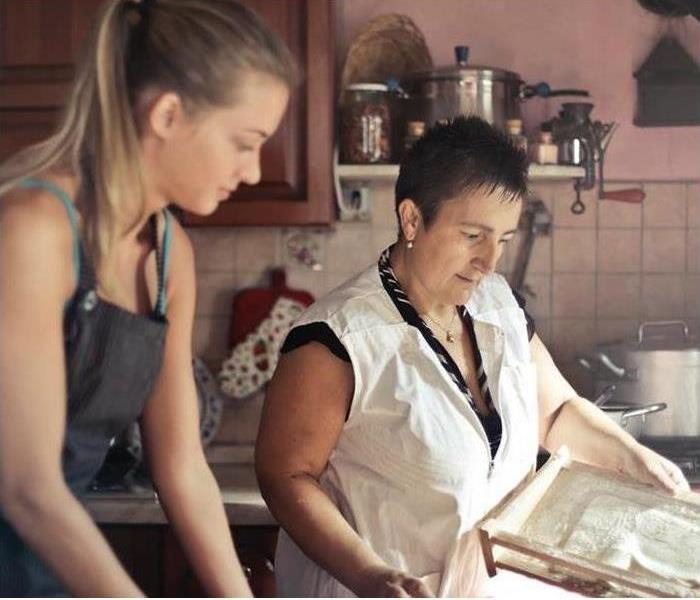 Fire Safety is Important!
Fire Safety is Important!
Mealtime is a time when families get together. We all look forward to cooking a wonderful meal while visiting with our loved ones. When in the kitchen, you should practice fire safety, so that you can prevent a fire in this room known as the heart of the home. Fire damage can be incredibly costly; a single fire may cause hundreds if not thousands of dollars in fire damage, and can put those you love at risk. Here are some fire prevention tips for your kitchen:
Cleanliness. Before you even begin to prep for the meal, ensure that the entire kitchen is clean by clearing all grime from the oven, washing the microwave, and making sure the floors are swept. Leftover food particles and grease can help a fire ignite before you know it. A clean kitchen is a safe kitchen.
Protection. When cooking, make sure to wear the right clothing. Don’t wear anything with dangling sleeves that could catch or spread a fire. Oven mitts are a must when you bring things out of the stove, too. Hot pots, pans, and utensils can catch other items on fire, so prepare a place to put them after you bring them out. Clear an area for hot items, and make sure the surface is clean and dry.
Children. Mealtime brings the kids into the kitchen, and they will enjoy help you by performing simple tasks, such as helping to get things out of the fridge. You can use this time to teach them fire safety and to ensure that they know to keep away from stoves and any other place where there might be live flames.
Proper Storage. One of the best ways to help prevent fires in your kitchen is to store all chemicals like solvents away from any heat source. Keep cleaning fluids on shelving that is protected far away from the stove and range, and make sure that any pots you are using have all handles away from everyone in the kitchen. Knocking a burning pot or pan onto the floor or a person can cause serious injuries and start a fire quickly.
Your kitchen should always be filled with friends, family, and food, and SERVPRO of Lansdale, Warminster, and Blue Bell is here to help make that happen. Whether your home suffers from fire damage, water damage, or a mold infestation, we are ready at a moment’s notice!
Fire Threats to Be Aware of In Your Restaurant
3/4/2020 (Permalink)
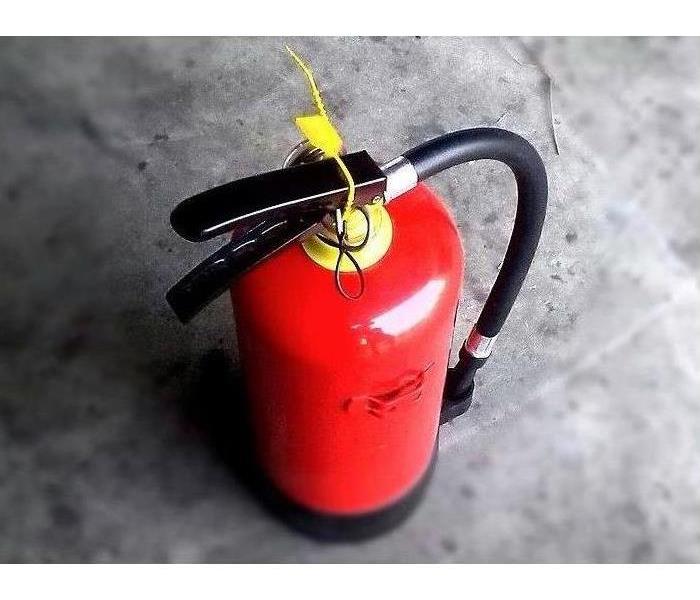 Always know where you fire hydrants are placed in your business!
Always know where you fire hydrants are placed in your business!
A restaurant kitchen fire can happen in no time, and in that environment, there are many fire threats to be aware of. Awareness and caution can help to keep fires from starting, and also be vital in keeping the fire from spreading, threatening peoples’ lives and damaging expensive property and equipment.
- The first fire threat you will think of will be the ovens. If there is a fire in an oven, close the door immediately and turn it off, leaving the door closed. Lack of oxygen will suffocate the flames. If the oven continues to smoke and you think the fire may have continued, call the fire department right away.
- The next threat will be your stovetops. When it is a fire in a cooking pan or pot, use an oven mitt or other protection to put the lid on right away, and move it off the burner. Turn off the stove and wait for the lack of oxygen to stop the flames inside your pot. If you are not able to safely put the lid on the flaming pan, or if there is no lid readily available, use the kitchen fire extinguisher. Always aim at the base of the fire, not the flames themselves.
- A major fire threat in any restaurant kitchen is going to be a grease fire. Never throw water on this type of fire; water repels grease and will splash, spreading the fire by splattering the grease. Try one of these methods instead:
- If the fire is small, put on the lid and turn off the burner.
- Dump baking soda on it. Do not use flour; it can explode or cause the fire to expand and thread.
- Smother the fire with a wet towel or other large, wet cloth.
- Use a fire extinguisher.
- Swatting the fire with a towel, apron, or other material is likely to fan the flames and spread the fire.
- If the fire is spreading and you don’t have control, evacuate your kitchen and restaurant premises and call emergency personnel.
For cleanup after any type of fire, the SERVPRO of Lansdale, Warminster, and Blue Bell is always ready to help. We have all the training, skills, and equipment necessary to get you back in business as soon as possible. We are also water damage and mold remediation specialists.
How to Properly Use Space Heaters
2/3/2020 (Permalink)
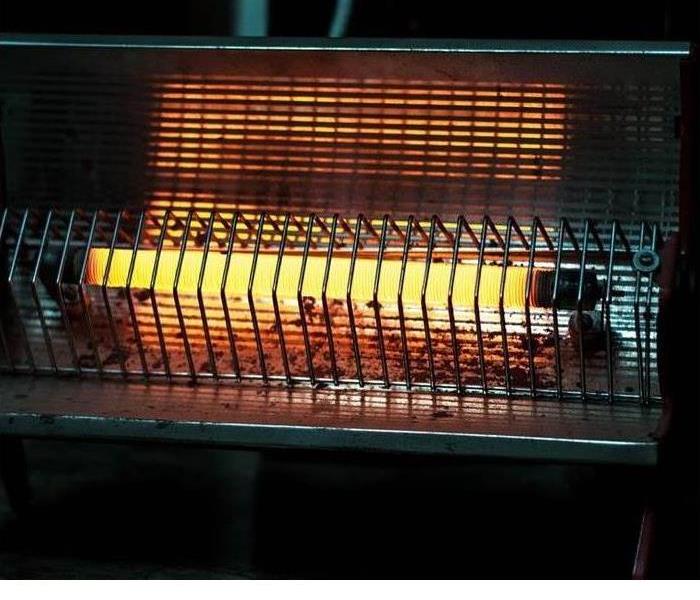 When used properly, space heaters can be a big help in cold weather!
When used properly, space heaters can be a big help in cold weather!
During the winter, your central heating system works overtime. Sometimes you may only need to heat one room and give your main heater a break by using a portable space heater - an effective option, and one that can save you some money, too.
These units are high-wattage appliances, though, and they do have the potential to cause fires in your home if not used correctly. Today, we are sharing some tips on the proper use of space heaters so that you and your loved ones can stay safe.
When Purchasing A Space Heater
- Label. Check to see that your heater is listed by a qualified testing laboratory.
- Smart Heaters. Purchase one with a sensor that will shut it off automatically if it overheats or gets tipped over.
- Preparation. Install smoke detectors in your home, as well as carbon monoxide alarms. These need to be tested monthly.
- Inspection. Inspect your heater and its cord and plug. Do not use it if you think it could be defective.
Setting Up Your Space Heater
- Placement. Place your heater on a solid flat surface, and make sure it’s at least 3 feet from anything flammable. If it is being used in the garage or workshop, keep it away from any paint, oil, and gas cans.
- Hazards. Don’t place the heater on furniture or cover it up, and be careful of high-traffic areas and doorways, where someone could trip over it and get burned. Never run a power cord under carpets, rugs, or furniture.
- Plugs. Plug your heater into an outlet directly instead of using an extension cord or power strip. Make sure the plug fits well and is the only plug in the outlet.
- Water. Always keep your heater away from water, and if you’re wet - don’t touch it.
Running Your Space Heater
- Check. Check your heater often to make sure that the plug, cord, outlet, or faceplate isn’t hot. If it is, stop using it immediately, and remember that a hot cord may mean it is defective and could ignite a fire.
- Time. Don’t run your heater 24/7. It isn’t made to work for long periods of time.
- Turn it off. Never leave a space heater unattended or in a child’s room, and turn it off while you are sleeping.
SERVPRO is Hiring!
10/4/2019 (Permalink)
 Join our team!
Join our team!
SERVPRO of Lansdale, Warminster, and Blue Bell is currently hiring Production and Cleaning Technicians.
The requirements for this position:
- Must have a professional appearance and great attitude.
- A valid driver license with a reasonable driving record.
- Ability to pass a criminal background check with no felony convictions or misdemeanors involving violence or theft.
- Must be able to pass a drug test.
- Because we provide 24-hour emergency services, must be willing to be on call, as needed.
- Some night and weekend work is required.
- Willing to travel for storm events
- Must be able to lift a minimum of 50 pounds.
- Must have a high school diploma or a GED certificate.
- Experience preferred but not necessary.
Please call 215.368.4110 or email resume to Megan.S@SERVPROWLBB.com
Smoke Alarm Safety
10/3/2019 (Permalink)
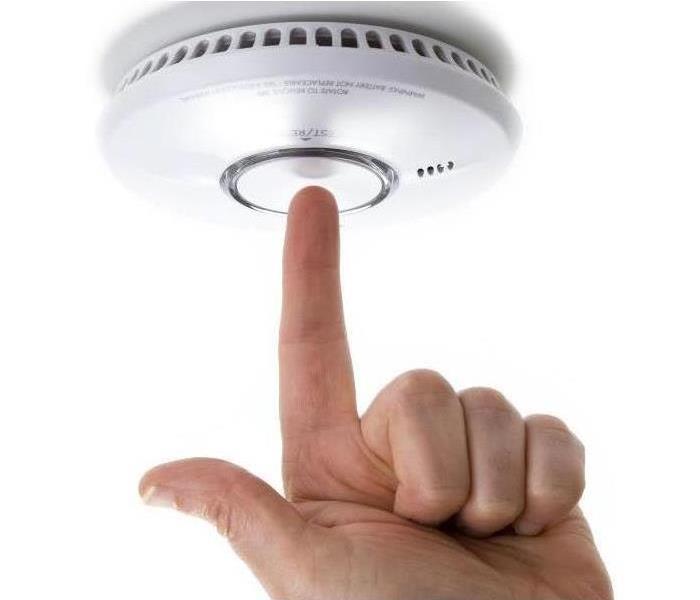 Smoke Alarm
Smoke Alarm
Smoke alarms play a vital role in saving lives, and when properly installed, can reduce the risk of fire injury in half.* The National Fire Protection Association
Smoke alarms work best when paired with a fire escape plan. A plan allows your family, employees or clients to escape quickly and safely in an emergency situation. Business owners should consult the local Fire Marshal to ensure specific building fire codes and smoke detector requirements are met.
SMOKE ALARM SAFETY TIPS:
-Install smoke alarms on every level of the home, including the basement according to alarm instructions. Larger homes may need more smoke alarms.
-Smoke alarms should be installed away from the kitchen and at least 10 feet away from a cooking appliance to prevent false alarms.
-Test smoke alarms at least once a month using the test button.
-Replace batteries in all smoke alarms at least once a year. If an alarm “chirps,” the battery is low and should be replaced right away.
-Replace all smoke alarms when they are 10 years old.
*Tips and statistics provided by the National Fire Protection Association.
When Water Damages Your Furniture
6/20/2019 (Permalink)
Water damage to your furniture is not always as bad as it might seem. Sometimes the damage is very manageable and can be repaired through some simple DIY steps. If you have some furniture that needs care after flooding or weather-related water damage, here are some tips you can follow to restore your furniture and carpeting.
Wood - When a piece of furniture made from wood has been soaked in water, the first step to be taken is to let it dry completely. Place it in a room that is warm and that enjoys good circulation. You can choose to turn on the heat and fans, as well. If the outdoor temperatures are warm, you may place the furniture outside, but take care that the temperature is warm enough - cold weather will cause the piece to dry more slowly and mold can establish a colony, while air that is too hot will cause cracks to form in the furniture.
White Spots - If you find white spots on the furniture, mix a solution of toothpaste and baking soda in equal parts. After dipping a wet cloth in this solution, rub it around and on the spots and polish the area with a dry piece of fabric made from cotton.
Mildew - Black spots indicate that water has seeped through the finish into the wood itself, and that leads to mildew. If this happens, it will require you to remove the finish, clean the mildew with a bleach solution and put on a new layer of finish.
Buckled Veneer - The veneer on your furniture may have buckled or warped through contact with water. You can soak the veneer with a moisturizer to cause it to lie down flat and then wipe it clean and dry. Next, fill a syringe with veneer glue, stick the needle between the veneer and the body of the furniture, emptying the syringe slowly. After it is removed, place a wood block on top of the veneer and wait for the glue to dry, following manufacturer recommendations.
When it comes to recovery of your property and possessions from water damage, the team at SERVPRO of Lansdale, Warminster, and Blue Bell is always here to help. We are experts in the area of restoration from the damages of fire or water, and we are also mold prevention and remediation experts
Smoke Damage in your Kitchen
4/12/2019 (Permalink)
The damages that fire can cause are, of course, significant and devastating. Smoke is a big issue as well, and very hard to get rid of. In the event of an oven or stove fire in your kitchen, you can be left with a mess that requires the help of professionals who know how to deal with the residue left behind, and that smell.
It’s not as easy as just opening a window and letting it all air out, unfortunately. The acidity of smoke and soot can make them difficult to remove, and they contain particles that are harmful to breathe, so it is going to be essential to clean the smoke damage completely as soon as possible.
There are a few things that a client can do themselves to alleviate smoke damage using items found in most homes, such as rubbing alcohol, vinegar, degreaser, and hot water. You will need one item that isn’t normally in your closet, and that is a dry-cleaning sponge.
Open all windows, even if it’s cold outside - ventilation is essential. Use fans, if necessary, to get air moving, and turn off your HVAC system to prevent the spread of the smoke and soot and their harmful particles.
Make sure you wear protection for yourself, such as long pants and long sleeves. Gloves and eye protection are important, as well, since you will be freeing soot as you clean. Lay down floor protection and remove furniture that is not damaged. You may be able to cover items with plastic if the affected area is small, but if it’s the whole kitchen it will be wise to simply remove everything and seal off undamaged areas.
This can become and overwhelming task, if that is the case, you may find it necessary to call a professional for help. Here at SERVPRO of Lansdale, Warminster, and Blue Bell, we have the expertise necessary to help you recover your kitchen from smoke damages
Odor Removal After a Fire Damage
4/2/2019 (Permalink)
Since homeowners do not expect or predict when disaster might strike, there are often common functions of the house that can exasperate the spread of the damage from an incident like a fire. With conditioned or heated air being a staple to nearly every home in the area, circulating air throughout your home is something that happens almost continually. Whenever situations like fires take place, a running HVAC system can become adversely affected and become instrumental in spreading damages like soot and smoke residue to otherwise unaffected areas of your property.
One of the hardest obstacles to overcome after a disaster like this in your home is your need for fire odor control. Smoke damage can seep into materials, fabrics, furniture, and much more. We have many pieces of equipment that can help to eliminate these harsh odors permanently from your home, and we also have specialized areas and tools at our facility to deodorize contents of your home removed during the mitigation phase and pack-out process.
Our SERVPRO professionals work to respond immediately to your emergency with the necessary mitigation to help protect the contents, furniture, and affected items within your home. These often get taken to our nearby facility for focused cleaning and deodorization efforts. The most effective approach for many of these items is time in an ozone chamber. This special compartment of our facility adds air with added oxygen to neutralize odor molecules in the items we have placed inside. This practice, even in portable units, is not safe for use around pets and your family, however.
To remove noxious fire odors in open areas and permanent fixtures throughout your damaged property, our SERVPRO professionals can combine the use of hydroxyl generators and thermal foggers. If there are no people or pets present in the home, ozone generators can also be a practical solution for deodorization in your home.
Restoring your home after a fire requires addressing lingering odor concerns throughout the house. Our SERVPRO of Lansdale, Warminster, and Blue Bell fire restoration specialists have the tools and expertise to help. Give us a call anytime at 215.368.4110
Additional Items to Consider with a Fire / Smoke Loss
3/21/2019 (Permalink)
Fires are devastating and can cause major damage to your home or business, which can often require you to hire licensed professionals to make the repairs. The extent of the damage will all depend on the fire itself, how it started, and how long it burned, and how it was put out. A few determining factors when it comes to fire damage restoration cost will be:
- The number of affected rooms
- The amount of damage
- Repairs needed
You probably also know that water damages will be extensive, since this is what is often used in the fighting of the fire. Water can damage walls, floors and furniture, and if not handled quickly, the damage can get worse over time. In addition, mold can easily take hold in damp conditions.
There are a few additional costs of fire damage restoration that you might not know about, such as:
- Soot removal and cleanup. Soot can build up on curtains, walls, floors, and contents
- Cleanup of burnt materials. All the materials that have been burned and are no longer usable or are obstructive will need to be removed by professionals.
- Smoke damages. Clothing, carpet, and draperies absorb smoke, and the strong odor left behind will only get worse over time. Cleanup must take place at the source, and only after soot and water damage are removed. Thermal Fogging, Ozone treatment, and air-filtration along with specialty textile restoration and electronics restoration are the most common methods.
- Air ducts. Vent and duct cleaning will prevent lingering odors from spreading.
In the event of a fire at your home or business, call the professionals at SERVPRO of Warminster, Lansdale, and Blue Bell for help with fire damage restoration, water damage restoration, mold remediation, and so much more. We are here to help.
via LinkedIn
Fire Prevention in your Garage
5/30/2018 (Permalink)
SERVPRO Fire Prevention Tips
The garage runs a close second to the kitchen when it comes to areas of the home that are a common source of fire damage. You store cars in the garage, and many people use this room for working on them, meaning there is gas or oil, or other flammable materials in this enclosed space. Add to this the clutter which goes with it and the fact that garages are storage spaces for flammable items, and you have the perfect place for fires to start.
As with anything else when it comes to fire damage in your garage, being proactive is the best defense to keep your home as safe as possible from fire. Fuels, fluids, and cleaners should be sealed properly, and flammable materials stored away from elements which are flammable as well.
If the worst has already happened and a fire broke out, you can call us at SERVPRO. We are a professionally trained fire damage remediation company, and we have the tools and knowledge to help you restore your home back to its original condition.
Electrical devices in a garage need to be used carefully. Do not overload the circuit box, and unplug any units when not in use. You should also have a fire extinguisher in your garage. Clear any clutter out of your garage, as it makes it safer when you are walking around, but also cuts down on the probability of a fire spreading in the event of an emergency.
Flammable liquids need to be stored in small amounts and away from heat sources of any kind such as space heaters, vents, and pilot lights. Also, keep propane tanks outdoors. They are equipped and made sturdy for outdoor storage.
After a fire, there are several forms of damage including smoke and soot, plus water damage from putting the fire out. SERVPRO technicians take care of all of it for you, restoring anything salvageable, cleaning up the smoke and soot, and drying out the area and your possessions.
Fires in garages can spread just as quickly, if not faster, than other areas of your home due to several flammable items. Give SERVPRO of Lansdale a call as soon as the fire is safely out so we can salvage all that is possible. You can reach us at any time you need by dialing 215.368.4110
Smoke and Soot Cleanup
5/11/2017 (Permalink)
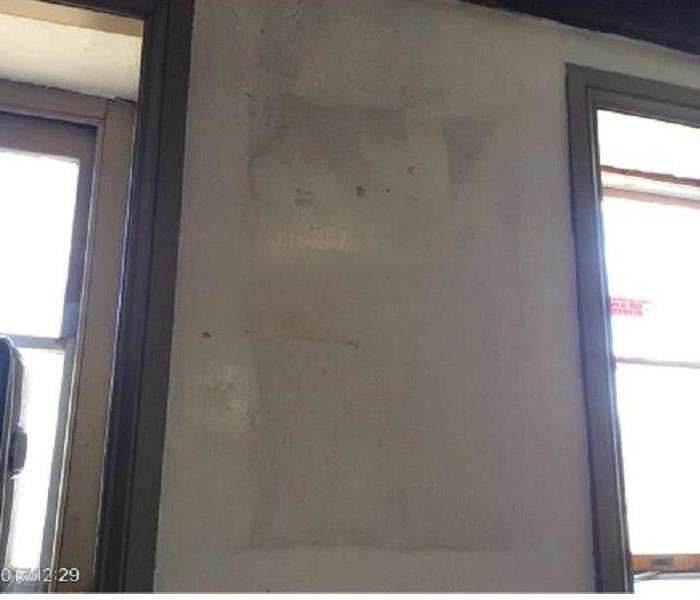 Soot damage to a bedroom wall.
Soot damage to a bedroom wall.
Smoke and soot is very invasive and can penetrate various cavities within your home, causing hidden damage and odor. Our smoke damage expertise and experience allows us to inspect and accurately assess the extent of the damage to develop a comprehensive plan of action.
Smoke and soot facts:
- Hot smoke migrates to cooler areas and upper levels of a structure.
- Smoke flows around plumbing systems, seeping through the holes used by pipes to go from floor to floor.
- The type of smoke may greatly affect the restoration process.
Different Types of Smoke
There are two different types of smoke–wet and dry. As a result, there are different types of soot residue after a fire. Before restoration begins, SERVPRO of Lansdale will test the soot to determine which type of smoke damage occurred. The cleaning procedures will then be based on the information identified during pretesting. Here is some additional information:
Wet Smoke – Plastic and Rubber
- Low heat, smoldering, pungent odor, sticky, smeary. Smoke webs are more difficult to clean.
Dry Smoke – Paper and Wood
- Fast burning, high temperatures, heat rises therefore smoke rises.
Protein Fire Residue – Produced by evaporation of material rather than from a fire
- Virtually invisible, discolors paints and varnishes, extreme pungent odor.
Our Fire Damage Restoration Services
Since each smoke and fire damage situation is a little different, each one requires a unique solution tailored for the specific conditions. We have the equipment, expertise, and experience to restore your fire and smoke damage. We will also treat your family with empathy and respect and your property with care.
Have Questions about Fire, Smoke, or Soot Damage?
Call Us Today - 215-368-4110






 24/7 Emergency Service
24/7 Emergency Service























